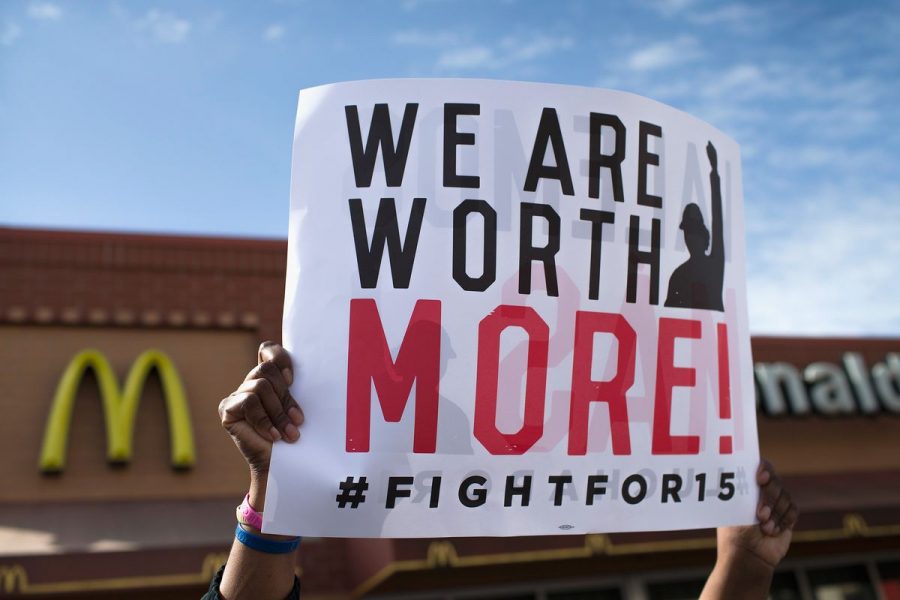The Minimum Wage Needs to be Raised
The minimum wage, and the rate at which it is set, is an extremely important factor in the health and wellbeing of working people throughout the country. How it is set not only determines the wages of the millions of people living on minimum wage, but also low-wage workers. Many earning wages at the federal minimum rate currently live in poverty. What the minimum wage is set at determines the living standard, health, and well-being of millions of low-wage workers, both those who earn the minimum and those who earn an hourly rate just above it. The minimum wage, and whether it is increased, is an issue that impacts millions of people.
The minimum wage must be increased. It is imperative for the general wellbeing of all workers earning at or near the minimum rate.
One simply cannot survive on an hourly wage of $7.25 as their income. The majority of workers earning less than $10 per hour can barely afford, or cannot afford, their basic living expenses (Oxfam America, 2013). A wage of $7.25 per hour is less than half of a living wage for a single adult with no dependents. An adult, with two children, earning an hourly rate of $7.25 per hour falls far below the poverty threshold (House Committee on Education and Labor). An adult would have to work 93 hours per week at the federal minimum wage in order to afford their basic needs (Alliance for a Just Society, 2015). A worker must earn an hourly wage of at least $15.50 in order to afford a one-bedroom apartment. (National Low Income Housing Coalition, 2015). One cannot sustain a healthy lifestyle, or even meet their basic needs, on the current minimum wage.
The minimum wage has not risen to compensate for the increase in the productivity of labor. The rate of general productivity has elevated drastically, having increased 69.6% between 1979 and 2018. During the same period, wages only increased by 11.6% (Economic Policy Institute, 2019). So while companies experienced growth in production, wages stagnated, and the workers never saw these benefits. A minimum wage that increased at the same trend as productivity would now be $18.67 per hour (AFL-CIO). Due to inflation, the minimum wage is worth 14.8% less than when it was last increased in 2009. In fact, the value of the minimum wage peaked in 1968 and is now worth 28.6% less than it was then (Economic Policy Institute, 2019). The minimum wage, due to multiple factors, is significantly less than it should be.
In order to address this issue, we need legislation that would increase the federal minimum wage to $15 per hour as early as 2023. In addition to this, an effective implementation of wage increases would require legislation that imposes rent controls, to ensure more affordable housing for workers earning low wages. Once the $15 per hour rate is achieved, the minimum wage should also be adjusted based on increases in the median wage, in order to prevent the growth of income inequality. Unless this problem of economic injustice is dealt with urgency, it will inevitably become a crisis of poverty.
Sources:
Alliance for a Just Society. “Pay Up! Long Hours and Low Pay Leave Workers at a
Loss.” Alliance for a Just Society. Last modified October 2015.
http://allianceforajustsociety.org/wp-content/uploads/2015/10/
Pay-Up-Revised-FINAL.pdf.
The American Federation of Labor and Congress of Industrial Organizations.
“Raising the Minimum Wage.” The American Federation of Labor and Congress
of Industrial Organizations. https://aflcio.org/what-unions-do/
social-economic-justice/minimum-wage.
Economic Policy Institute. “The Productivity–Pay Gap.” Economic Policy
Institute. Last modified July 2019. https://www.epi.org/
productivity-pay-gap/.
“Out of Reach 2015.” National Low Income Housing Coalition. Last modified 2015.
https://nlihc.org/sites/default/files/oor/OOR_2015_FULL.pdf.
Oxfam America. “Hard Work, Hard Lives.” Oxfam. Last modified August 28, 2013.
https://s3.amazonaws.com/oxfam-us/www/static/oa4/
low-wage-worker-report-oxfam-america.pdf.
Scott, Robert C. “Raising the Minimum Wage: Good for Workers, Businesses, and
the Economy.” House Committee on Education and Labor. https://edlabor.house.gov/imo/media/doc/FactSheet-RaisingTheMinimumWageIsGoodForWorkers,Businesses,andTheEconomy-FINAL.pdf.
United States Bureau of Labor Statistics. “Characteristics of minimum wage
workers, 2018.” United States Bureau of Labor Statistics. Last modified
March 2019. https://www.bls.gov/opub/reports/minimum-wage/2018/pdf/
home.pdf.


